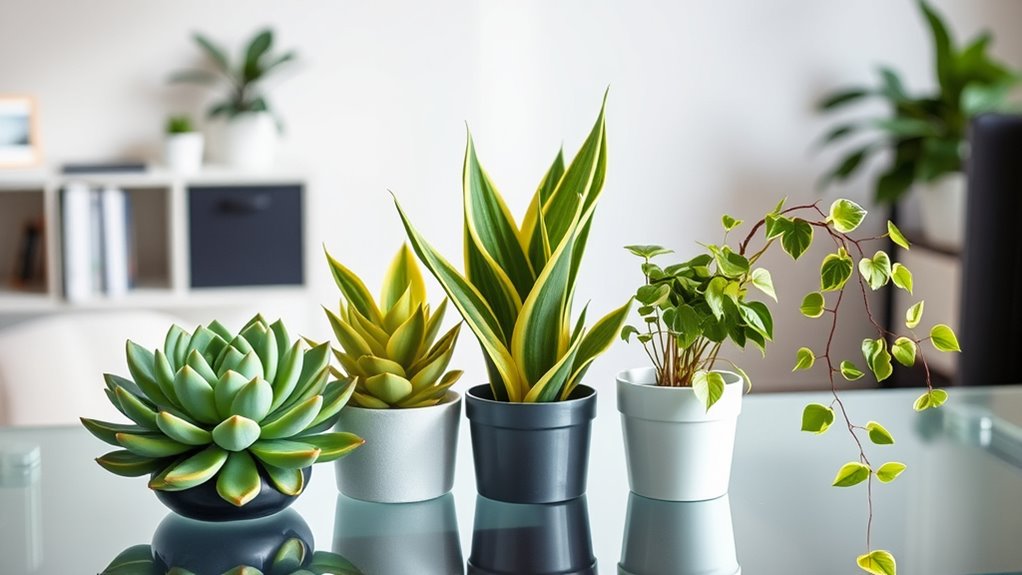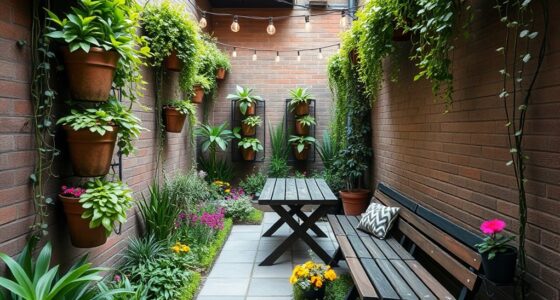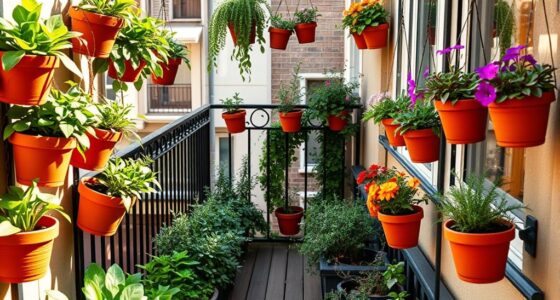Looking for easy-to-care-for plants to brighten your office desk? Opt for low-maintenance greens like snake plants, pothos, ZZ plants, peace lilies, and philodendrons. These thrive in low light, only need watering every few weeks, and require minimal pruning. Want to transform your workspace effortlessly? Keep exploring to discover more about the best plants that bring nature’s benefits with hardly any effort.
Key Takeaways
- Choose low-maintenance plants like snake plants, pothos, ZZ plants, peace lilies, and philodendrons that thrive with minimal care.
- Prioritize plants with low light tolerance and infrequent watering needs to suit typical office environments.
- Opt for varieties that improve air quality, such as snake plants and peace lilies, enhancing workspace health.
- Use well-draining soil and avoid overwatering to prevent root rot and ensure plant longevity.
- Select compact, easy-to-care-for options like aloe vera, spider plants, and jade plants for practical desk placement.
Snake Plant (Sansevieria)
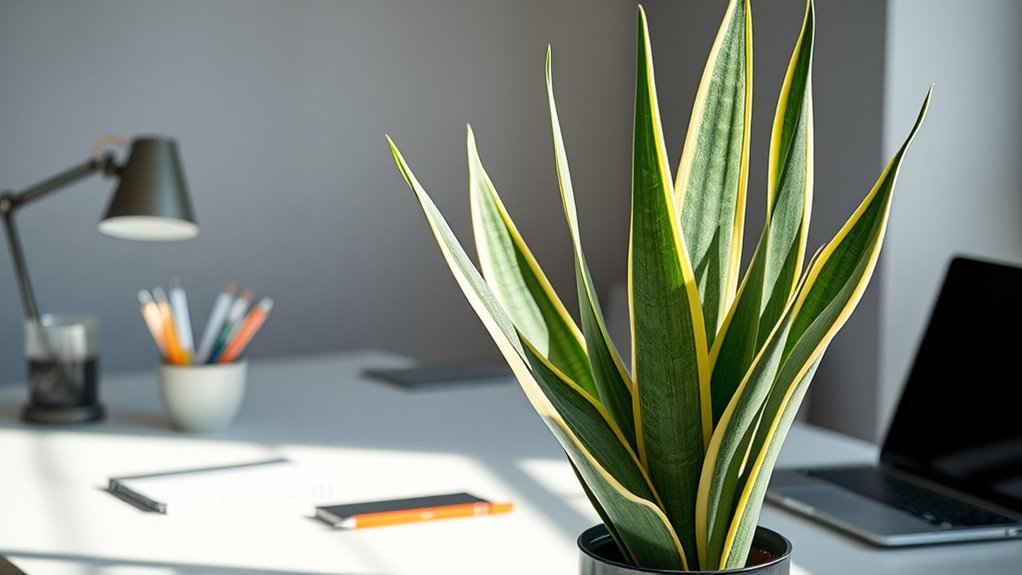
The Snake Plant (Sansevieria) is one of the best choices for your office desk because it requires minimal maintenance and thrives in low light. When it comes to plant watering, you only need to water it sparingly—about once every 2-3 weeks—and guarantee the soil dries out completely between waterings. Overwatering can lead to root rot, so less is more. Foliage maintenance is simple; you can wipe the leaves occasionally with a damp cloth to remove dust and keep it looking vibrant. This plant’s upright, stiff leaves naturally stay tidy, so you rarely need to trim or prune. Overall, the Snake Plant offers a low-effort, stylish addition to your workspace that stays healthy with minimal attention.
Pothos (Epipremnum Aureum)
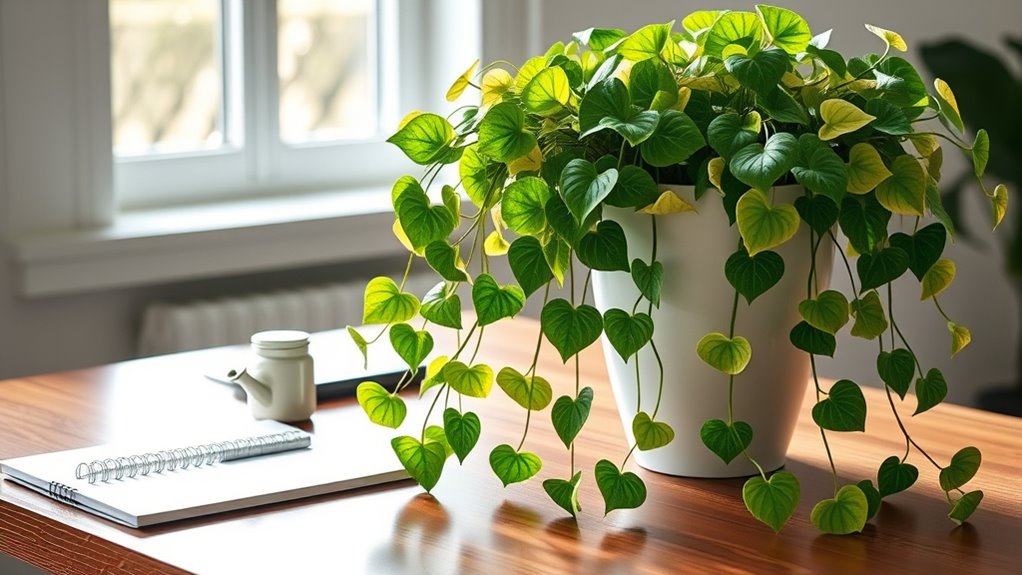
Ever wondered why Pothos (Epipremnum aureum) is a popular choice for office desks? It’s because this hardy plant thrives with minimal care. You should water it when the top inch of soil feels dry, usually every one to two weeks. Avoid overwatering, as soggy soil can lead to root rot. Pothos prefers well-draining soil, such as a mix designed for houseplants that combines peat, perlite, and compost. Its adaptable nature allows it to grow in a variety of soil types, but good drainage is key. You don’t need to fuss over it; just water when needed, and place it in indirect light. This low-maintenance plant stays vibrant and healthy with simple watering habits and proper soil.
ZZ Plant (Zamioculcas Zamiifolia)
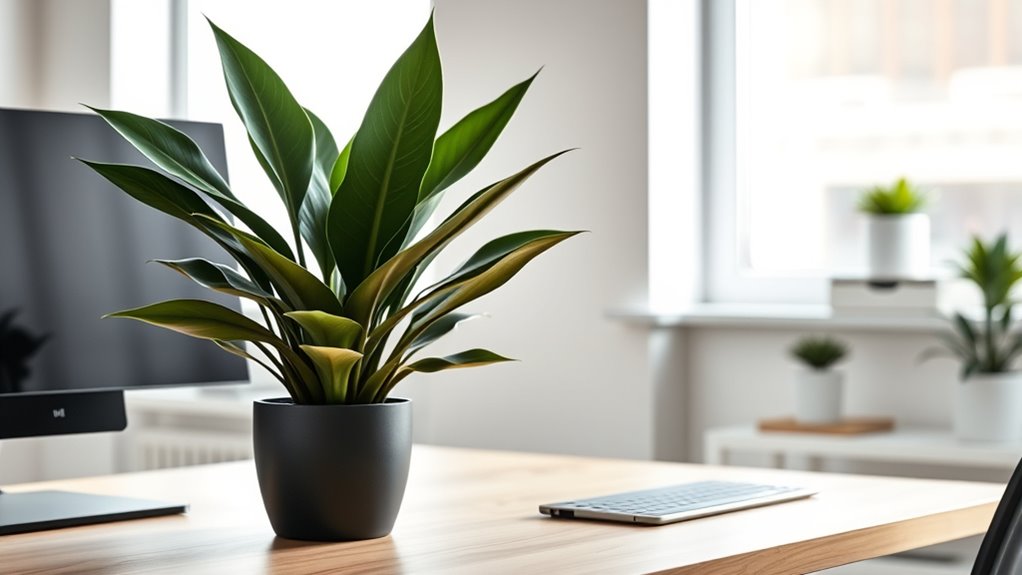
If you’re looking for a plant that requires minimal effort and can survive in low light conditions, the ZZ Plant (Zamioculcas zamiifolia) is an excellent choice for your office desk. It thrives with a simple watering schedule—water only when the soil is completely dry, roughly every 2-3 weeks. Overwatering can lead to root rot, so less is more. The soil needs to be well-draining; a standard potting mix with added sand or perlite works well. ZZ Plants are tolerant of neglect and adapt easily to indoor environments. They don’t need frequent watering or high humidity, making them perfect for busy office settings. Keep them away from direct sunlight, and you’ll enjoy their glossy, attractive leaves with minimal fuss. Understanding the importance of light conditions can help optimize the plant’s appearance under various indoor lighting conditions, and selecting plants with low-maintenance requirements ensures a hassle-free greenery addition.
Peace Lily (Spathiphyllum)
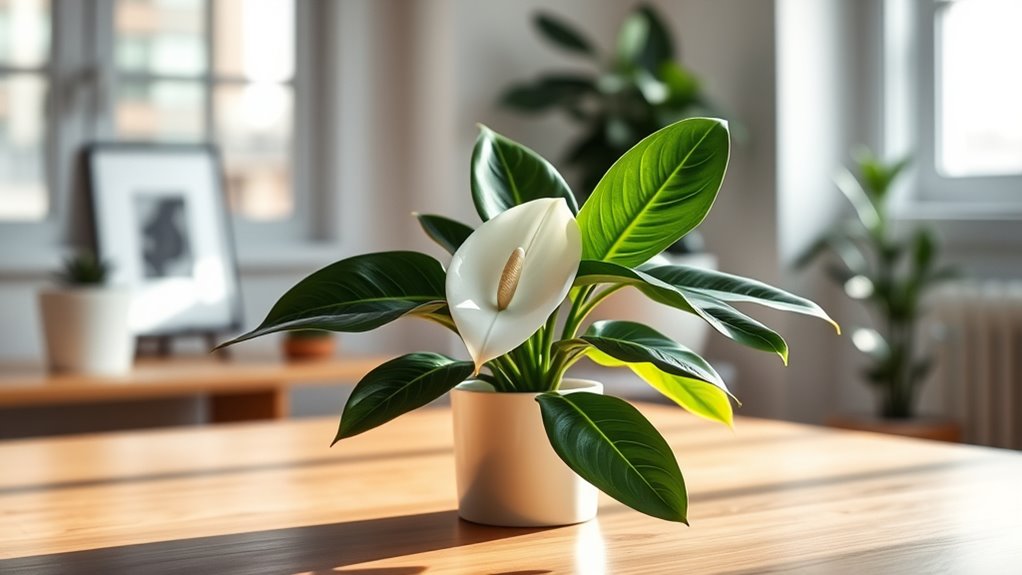
A Peace Lily (Spathiphyllum) is a great choice for your office desk because it’s known for its air-purifying properties and elegant appearance. It thrives in indoor humidity, making it suitable for office environments where humidity levels fluctuate. The plant’s lush, dark green leaves and white blooms add a touch of sophistication to any workspace. Peace Lilies are naturally pest-resistant, so you don’t need to worry about frequent maintenance or chemical treatments. They prefer low to moderate light, which is perfect for office settings, and they don’t require frequent watering—just keep the soil moist. With minimal fuss, this plant improves indoor air quality while maintaining a stylish look, making it an excellent low-maintenance green for your desk. Additionally, choosing compact designs can make it easier to fit within limited desk space. Incorporating plants like the Peace Lily can also promote energetic alignment and enhance your overall workspace environment. Considering its resilience and ease of care, the Peace Lily is an ideal choice for dog-friendly offices, where low-maintenance plants can thrive alongside busy pets.
Philodendron
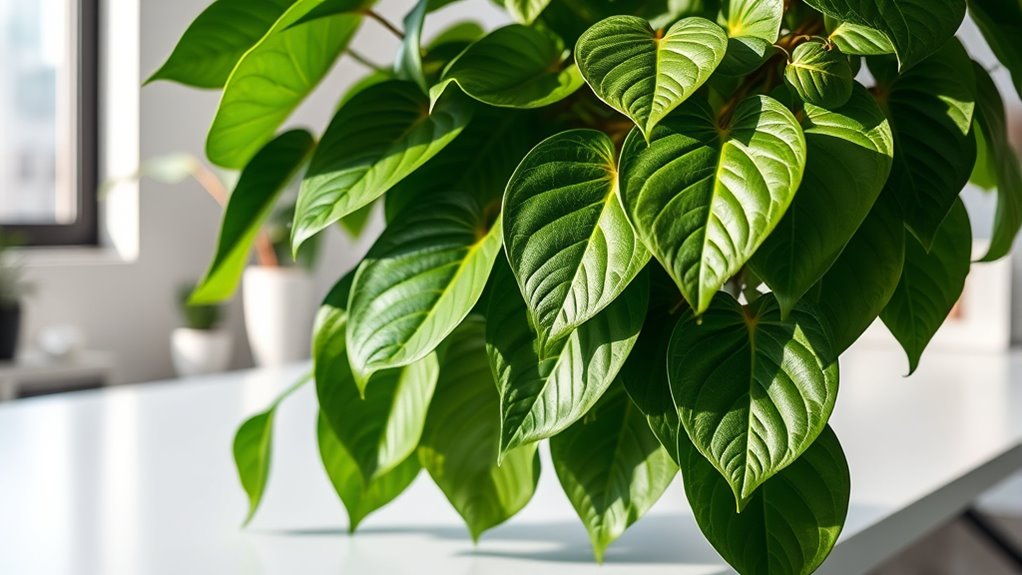
A philodendron is a great choice for your office because it’s easy to care for and doesn’t require much attention. It also helps improve air quality, making your workspace healthier. Plus, it thrives in low light, so you don’t need a sunny spot to keep it happy. Additionally, its low-maintenance nature makes it ideal for busy environments or those new to plant care. Being aware of privacy policies and how your data is managed can help you make informed decisions about your online environment. As automation continues to advance, selecting plants like the philodendron can contribute to a more comfortable and productive workspace, especially as offices incorporate more intelligent systems to enhance employee well-being.
Easy to Care For
Because it’s so adaptable, the philodendron is one of the easiest plants to care for on your office desk. You don’t need a strict watering schedule—water when the top inch of soil feels dry, usually once a week. Overwatering can lead to root rot, so verify your pot has good drainage. Pest control tips are simple: keep an eye out for common pests like spider mites or mealybugs, and wipe leaves with a damp cloth or use insecticidal soap if needed. The philodendron thrives in low to bright indirect light, making it flexible for various office environments. Its forgiving nature means you won’t have to stress over perfect conditions, making it an ideal low-maintenance green for your workspace. Using a self-watering plant pot can help maintain consistent moisture and reduce watering concerns, especially with necessary cookies that track watering habits for optimal plant care. Additionally, choosing plants with sustainable qualities can support eco-friendly office practices.
Air Purifying Benefits
The philodendron actively improves indoor air quality by filtering out common pollutants. It absorbs formaldehyde, xylene, and ammonia, helping to create a healthier workspace. As it works, it also adds to your office’s natural aesthetics, blending greenery seamlessly with your decor. Plus, it helps regulate indoor humidity, preventing the air from becoming too dry. Imagine the vibrant green leaves, which not only look fresh but also contribute to a more comfortable environment. Visualize the plant’s lush foliage softly filtering the air, making your workspace feel more inviting. With its low-maintenance nature, the philodendron continuously enhances your indoor air quality without extra effort. Understanding performance tuning laws can help you choose the best health-boosting plants for your space. Regular watering and proper placement can optimize the plant’s air purification capabilities, ensuring it functions effectively over time. Additionally, selecting plants with effective pollutant absorption properties can further improve your indoor environment.
Low Light Tolerance
Since philodendrons can thrive in low-light conditions, they’re an excellent choice for offices with limited natural sunlight. They tolerate low light well, making plant care simple. You don’t need to place them near windows; they’ll still grow healthily. To keep your philodendron happy, avoid overwatering and let the topsoil dry out between waterings. Additionally, understanding plant care principles can help ensure your green companions stay healthy. Being aware of light requirements can further optimize their growth in indoor environments. Recognizing the importance of indoor light levels can help you create the ideal environment for your plants to flourish.
Aloe Vera
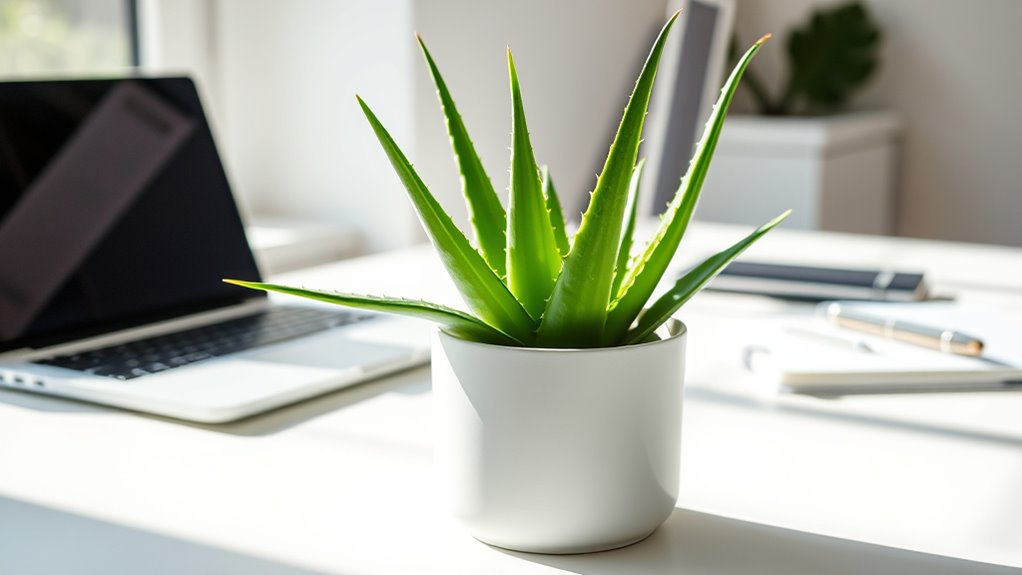
Aloe Vera is a popular choice for office desks thanks to its low maintenance needs and numerous health benefits. You’ll want to establish a simple watering schedule—about every three weeks—allowing the soil to dry out completely between waterings. When choosing soil, opt for a well-draining cactus or succulent mix to prevent overwatering and root rot. Imagine the plant’s thick, fleshy leaves absorbing sunlight while requiring minimal attention. Picture watering just enough to keep the soil moist but not soggy, and placing it near a window with indirect light. Its hardy nature makes it perfect for busy office environments, and you’ll enjoy the added benefit of having fresh aloe gel for skin or minor cuts. This plant is both functional and stylish on your desk.
Spider Plant (Chlorophytum Comosum)
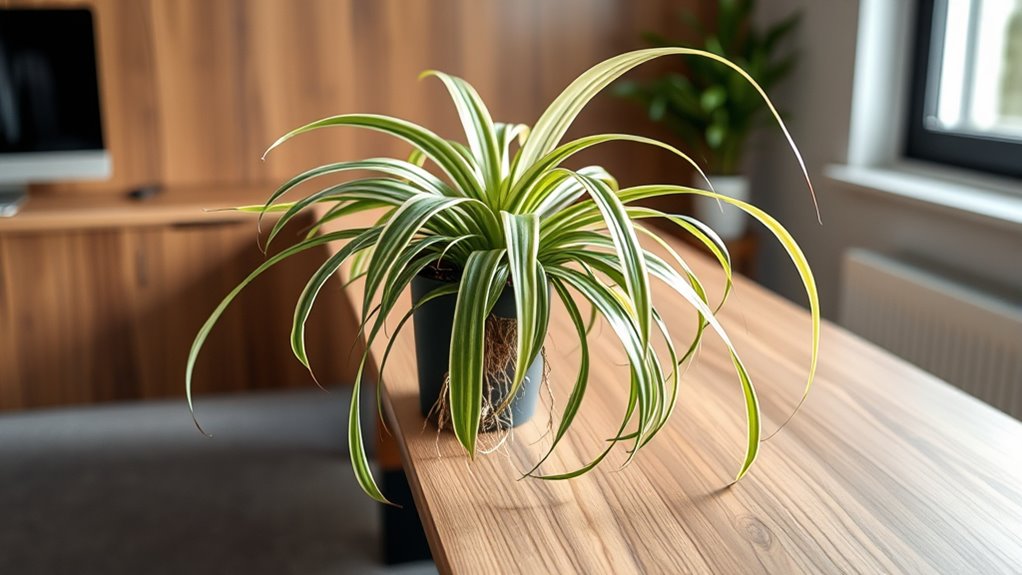
Looking for a lively, easy-to-maintain plant that brightens up your office space? The spider plant (Chlorophytum comosum) is perfect. It features unique growth patterns, with arching leaves and dangling plantlets that add visual interest. This resilient plant adapts well to indoor conditions and requires minimal care. When it comes to watering needs, keep the soil moist but not soggy—typically once a week. Overwatering can lead to root rot, so ensure proper drainage. Its fast growth patterns mean you’ll see new shoots regularly, making it an engaging addition. To emphasize its benefits:
| Aspect | Details |
|---|---|
| Growth Patterns | Arching leaves with trailing plantlets |
| Watering Needs | Weekly, with well-draining soil |
| Maintenance Level | Very low, thrives on neglect |
| Light Requirements | Indirect sunlight preferred |
| Overall Durability | Very hardy, forgiving of occasional neglect |
Additionally, its adaptability to varying hours makes it an especially suitable choice for busy office environments. The plant’s ability to thrive in low-light conditions further enhances its suitability for typical office settings.
Jade Plant (Crassula Ovata)
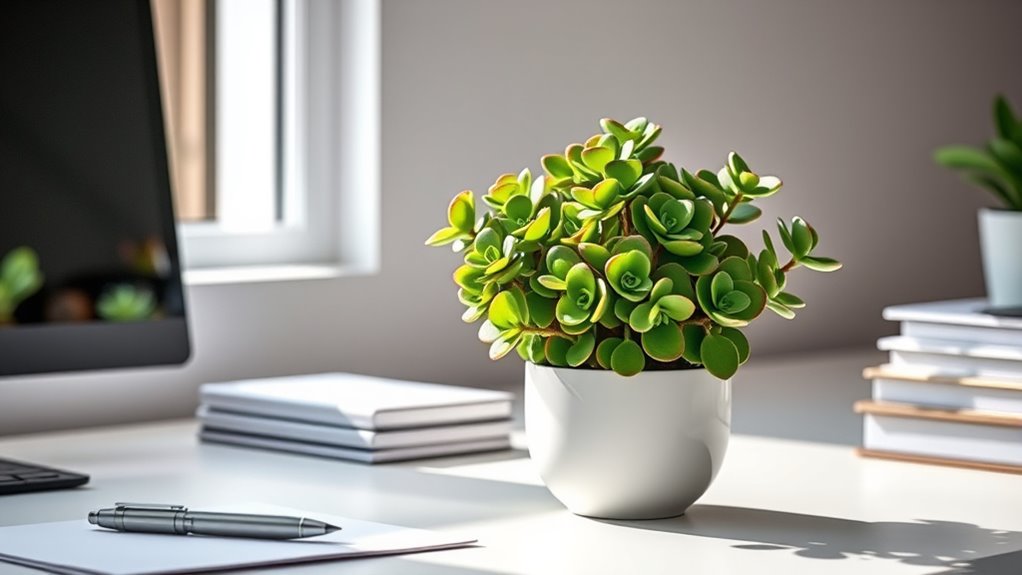
The Jade Plant (Crassula ovata) is a popular choice for office desks due to its easy care and attractive, fleshy leaves. To keep it thriving, follow these care tips:
- Place it in bright, indirect sunlight to promote healthy growth.
- Water it sparingly—about once every 2-3 weeks—allowing the soil to dry out completely between waterings.
- Use well-draining soil and a pot with drainage holes to prevent root rot.
Stick to a consistent watering schedule, and avoid overwatering, which can harm the plant. The thick, glossy leaves will catch your eye, adding a touch of greenery to your workspace. With minimal fuss, your Jade Plant will stay vibrant and healthy, making it an ideal low-maintenance desk companion.
Rubber Plant (Ficus Elastica)
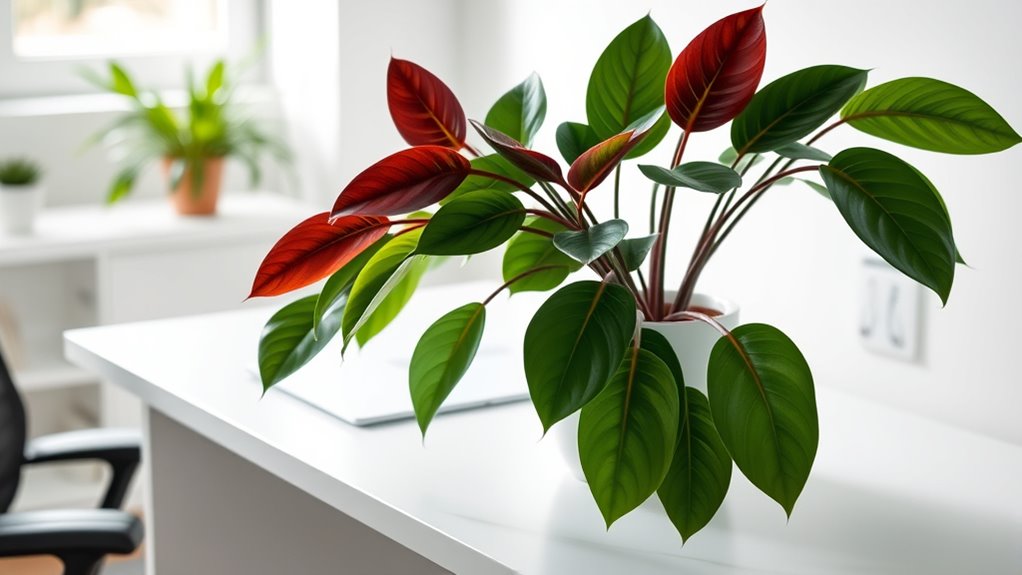
The Rubber Plant (Ficus Elastica) is a great choice for your desk because it’s easy to care for and doesn’t require much maintenance. It also helps improve air quality, making your workspace healthier. Plus, its compact size fits well in small spaces without taking up too much room.
Easy to Care For
Because it requires minimal attention, the Rubber Plant (Ficus elastica) is an excellent choice for busy office environments. You won’t need to worry about frequent watering; once every 1-2 weeks is enough, allowing the soil to dry out between waterings. It thrives in bright, indirect sunlight, so place it near a window with filtered light or in a well-lit corner. Imagine a lush, shiny-leaved plant standing tall on your desk, adding greenery without demanding constant care. Picture yourself glancing at its vibrant leaves, knowing it’s happily growing with minimal effort. Its hardy nature means you can focus on your work while your office stays lively and fresh. The Rubber Plant truly combines beauty and ease for your workspace.
Air Purification Benefits
While often appreciated for its aesthetic appeal, the Rubber Plant (Ficus elastica) also actively improves indoor air quality. It filters out common pollutants like formaldehyde and xylene, helping to create a healthier workspace. By reducing airborne toxins, the Rubber Plant can enhance your overall air quality, making it easier to breathe and supporting respiratory health. Its large, glossy leaves absorb pollutants efficiently, making it a great natural air purifier. Plus, it’s low-maintenance, so you don’t have to worry about frequent care. Including a Rubber Plant on your desk or in your office can help you breathe cleaner air, stay energized, and maintain better respiratory health throughout the workday. It’s a simple, effective way to boost your indoor environment.
Space-Saving Size
A compact Rubber Plant (Ficus elastica) can fit comfortably on your office desk or in small corner spaces without overwhelming your workspace. Its compact growth ensures it remains manageable, making it ideal for limited spaces. With a space-efficient design, this plant adds greenery without cluttering your environment. Imagine:
- Sitting next to your computer monitor, providing a fresh look.
- Filling a tiny nook with lush, vibrant leaves.
- Sitting atop a filing cabinet without blocking access or light.
Its small size makes it easy to move and adjust, while still delivering the benefits of greenery. This plant’s space-saving size is perfect for maintaining a tidy, lively work area, blending seamlessly into your office setup without taking up too much room.
Frequently Asked Questions
Which of These Plants Are Most Effective at Improving Indoor Air Quality?
When considering which plants improve indoor air quality, focus on air purifying options. These plants actively filter toxins and boost air quality, making your workspace healthier. You’ll want plants like pothos or snake plants, which are known for their air purifying abilities and low maintenance. By choosing these, you create a cleaner, fresher environment, helping you breathe easier and stay more productive throughout your workday.
Are These Plants Toxic to Pets or Children?
You might worry about pet safety and plant toxicity when choosing office plants, but many low-maintenance greens are safe. For example, snake plants and pothos are toxic to pets and children, so avoid them if you have curious little ones. Instead, opt for plants like spider plants or certain succulents, which are generally non-toxic. Always double-check plant labels or consult a vet for peace of mind and safe plant choices.
How Often Should I Water Each of These Low-Maintenance Plants?
You should water each low-maintenance plant based on its specific watering frequency, which varies by type. Generally, check the soil moisture regularly; most plants need watering once every one to two weeks. Follow plant care tips like avoiding overwatering, ensuring proper drainage, and adjusting watering based on indoor humidity and season. This approach keeps your plants healthy and thriving, making your office greener and more inviting.
Can These Plants Survive in Low-Light Office Environments?
You might wonder if these plants can thrive in low-light office settings. They often struggle without enough sunlight, but artificial alternatives and decorative containers can help maintain a vibrant look. If real plants can’t survive, consider using faux plants to add greenery without care. For real ones, choose varieties like snake plants or pothos, which tolerate low light. Just guarantee they’re placed in suitable containers to support their health.
What Are the Common Pests or Diseases That Affect These Plants?
When caring for office desk plants, you’ll want to watch out for common pests like spider mites, aphids, and mealybugs, which can hinder their health. To prevent these issues, practice pest prevention by regularly inspecting your plants and keeping the environment clean. Diseases such as leaf spot or root rot can also affect them, so focus on effective disease management through proper watering and good airflow to keep your plants thriving.
Conclusion
Think of your desk as a tiny island where these resilient plants thrive, each one a steadfast lighthouse guiding your workspace to greener shores. With minimal care, they stand tall like quiet guardians, turning your office into a lush haven. Embrace these low-maintenance greens and watch your environment transform into a vibrant oasis. Just as lighthouses bring clarity and calm, your plants will bring life and tranquility to your daily routine.
